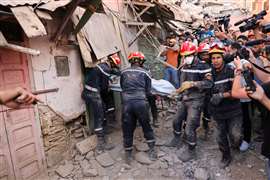Impact of Morocco earthquake worsened by old construction methods
11 September 2023
 Emergency workers carry a dead body, in the aftermath of a deadly earthquake, in Amizmiz, Morocco, September 10, 2023. REUTERS/Nacho Doc
Emergency workers carry a dead body, in the aftermath of a deadly earthquake, in Amizmiz, Morocco, September 10, 2023. REUTERS/Nacho Doc
The effects of the earthquake that occurred in Morocco on 8 September were made worse due to the traditional construction methods used in most of the buildings, according to industry experts.
The epicentre of the devastating earthquake was in the High Atlas Mountains, about 71km south-west of Marrakesh. This area doesn’t usually have a lot of earthquakes compared to other places near the edges of tectonic plates.
At the time of writing, it was estimated that over 2,100 people have lost their life and over 2,400 people have been injured. It is Morocco’s worst earthquake in more than sixty years.
Ziggy Lubkowski, Associate Director and seismic design expert at Arup, said, “Our thoughts are with the families impacted by this tragic event. This is the most devastating earthquake in the region since the 1960 Agadir event which resulted in 12,000 to 15,000 fatalities.
“The epicentre was located between Agadir and Marrakesh at the southern end of the Atlas Mountains therefore both cities were spared the full impact of ground shaking. The use of brick and adobe as a building material for residential properties will probably lead to a number of collapses. Unfortunately brick and adobe structures are very susceptible to earthquake shaking, due to their brittle nature.”
In a news report in NorthEastern Global News, Mehrdad Sasani, a professor of civil and environmental engineering at Northeastern University, US, was quoted as saying, “The most important problem here is that in that region, mud-brick construction and unreinforced masonry construction seems to be prevalent, and they fail when earthquakes come.
“We have seen that (failure) in the past, over and over again,” Sasani said. “It’s unfortunate – it’s a societal, economic and technical problem – and we will see repetitive problems where earthquakes will cause such damage.”
Jesús Galindo-Zaldivar, who has been carrying out research on the formation of the Atlas mountains and the geology, told Reuters Connect that, “The best way to minimise earthquake damage is to improve seismic building design codes to withstand the highest possible seismic activity. This will help buildings and other structures hold up better against strong shaking. In addition, it’s crucial that traditional homes and rock constructions in mountain villages be reinforced to prevent future disasters.
“New constructions must be tested and designed cheaply and efficiently, respecting new seismic building standards.”
STAY CONNECTED



Receive the information you need when you need it through our world-leading magazines, newsletters and daily briefings.
CONNECT WITH THE TEAM








